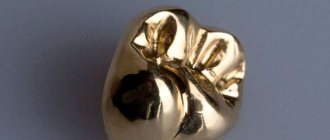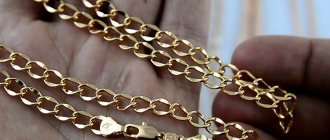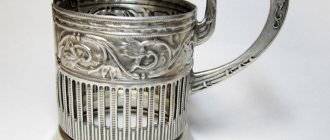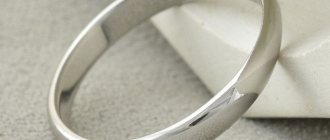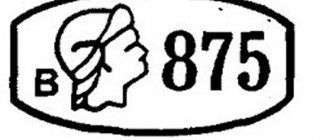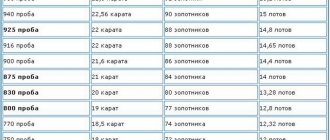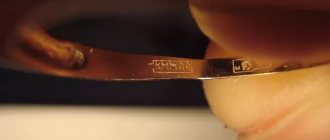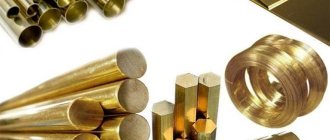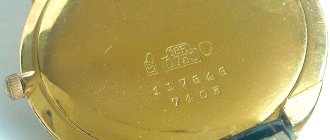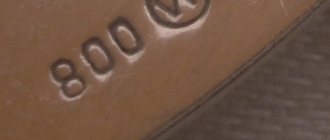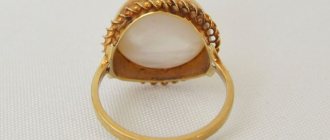Metals and compounds based on them are used in various industries. Cupronickel is an alloy that consists of copper and nickel. Other components may be added to the composition. Copper-based alloys are used in various fields. To understand where it is best to use cupronickel, you need to know what characteristics it has and what its strengths and weaknesses are.
Cupronickel cutlery
What is
In the list of chemical elements, the position “cupronickel” is absent.
Cupronickel is not a metal. This is an alloy of several components.
The basic components of cupronickel are copper and nickel. They are supplemented by iron and manganese, which are added to diversify the color range and consumer characteristics of the product.
Properties
Basic properties of the alloy:
- When cupronickel is heated, its strength improves, thereby increasing the durability of the product.
- If the components in the alloy are selected correctly, it will not be exposed to many organic acids and moisture.
- Contained in living organisms and supports their normal functioning.
Cupronickel silver is often used to make cleaning liquid. To do this, the alloy product is placed in water for 2–3 hours, and then washed with it.
Story
The Chinese were the first to obtain nickel silver from metals back in the 3rd century BC. But the alchemists of the Celestial Empire did not discover the secret of “white copper”.
Europeans unraveled the secret two millennia later:
- The French Maillot and Chaurier received the alloy by 1819.
- According to their authentic spelling – Maillot + Chorier – the alloy was christened.
- However, the term entered history modified: the Melchior variant seemed more harmonious to the Germans, and then to other peoples.
Melchior was the name of one of the trinity of wise men who came with gifts to the newborn baby Christ.
- In Russia (USSR), the term took hold by the 1930s, displacing the “German composition”, “serebrovid” and other variants.
- In Europe the term Cupronickel is in circulation.
An alloy that resembles a noble metal in description is also called Nickel silver, German silver, New silver (nickel, German, new silver).
Physico-chemical characteristics
Each of the components affects the physical and chemical properties of the alloy:
- External resemblance to silver.
- Wear resistance, strength.
- Plastic.
- Resistant to salt water and aggressive environments.
- Biological neutrality, compatibility with the human body.
- Low thermal and electrical conductivity.
The last property of the alloy seems to be a disadvantage, but for dishes or jewelry it is an advantage:
- The dishes do not heat up as quickly or strongly.
- Earrings or a ring do not heat up in the heat, so they do not injure the skin.
There is no single formula for cupronickel; the composition of the alloy is “mobile” (%):
- Copper – 70 – 95;
- Nickel – 29;
- Iron – maximum 0.79;
- Manganese – maximum 0.95.
The formula would look like CuNi , in an expanded version - CuNiFeMn .
There is no single alloy color or melting point. These characteristics are determined by the copper/nickel ratio. The temperature varies from 1145 to 1225°C. The more copper, the more intense the ocher reddishness.
Originally, cupronickel alloy contained zinc, but today it is a component (along with copper and nickel) of another alloy - nickel silver.
Pricing
The price of cupronickel products varies depending on many indicators:
- The number of components contained in the composition. In this case, it is necessary to take into account how much each of the impurities costs on the world market separately.
- Condition of the material. If the surface of the alloy has been subjected to additional treatment against corrosion or rust has begun to spread throughout the product, the price will be lower.
- We must not forget that prices for wholesale buyers are lower than for ordinary consumers.
- The cost of the finished product is influenced by the methods of its primary and secondary processing. If the material has been heated to improve performance, it will cost more.
Pure metals that make up the alloy are more expensive than their mixture. This is due to the processes of extraction and processing of raw materials.
Cupronickel is considered a popular alloy in various industries. Due to its similarity to silver, this material is used in jewelry making. However, without proper care, the appearance of a cupronickel product will quickly deteriorate.
Stamps
Cupronickel products made in Russia are marked with letters of the Russian alphabet and numbers:
- MN (copper and nickel).
- MNZHMts (plus iron and manganese).
- The numbers show the percentage of nickel, iron, manganese.
The amount of copper in the alloy marking is not indicated.
For example, the combination MNZHMts 45-4-1 is used to brand material made from 45% nickel, 4% iron and 1% manganese. The remainder (50%) goes to copper.
In industry, the most popular alloy grade is MH19. This is 18-20% nickel plus one and a half percent alloys (usually cobalt).
Where is it used?
The properties of cupronickel ensured its use by industrialists, decorators, and bankers.
Industry, medicine
The structure of the alloy allows all types of mechanical processing - cutting, forging, stamping, soldering. And at any temperature.
This determines the areas of application of cupronickel:
- High precision resistors, heat generators.
- Production of components for trawlers, cruise ships, ocean liners. And private yachts of the premium segment.
- In combination with lithium, nickel-iron alloys are purchased for the production of batteries. They are three times more effective than their analogues. Lithium, as the lightest metal, reduces the massiveness of the filling of nickel-zinc or ferrous batteries.
Cupronickel is a material for medical instruments: scalpels, forceps, etc.
Plus the possibility of decorative processing of products (chasing, cladding, polishing).
Decor
Decorators work with alloy in two directions:
- Jewelry. Rings, earrings, necklaces, and cufflinks made of cupronickel are indistinguishable from silver in appearance. However, large companies are not interested in the alloy due to its low cost. It is more often done by hand-made masters. The processing makes them look like museum pieces.
- Dishes. Sets of cupronickel tableware - spoons / forks / knives / sockets / tureens - are a pride and heirloom in many homes. Their advantages: they are several times cheaper than silver ones, but more durable and look presentable.
Especially good are gold-plated, silver-plated, blackened or other coated surfaces.
Applying such a layer is not only a tribute to aesthetics or status. Pure cupronickel imparts tangible metallic notes to food. Copper is toxic, especially when hot.
Banking sector
Wear resistance, coupled with low cost, prompted the National Banks of many countries to issue cupronickel coins.
Almost all silver-colored coins in circulation are made of cupronickel.
In the USSR and Russia, coinage is controlled by GOZNAK:
- In the 1930-1950s, nickels, 10-, 15-, 20-kopeck coins were issued.
Today, the subject of numismatists' hunt is a Soviet patch of the 1937 model.
- Since the 70s, the line has been supplemented with anniversary and regular “rubles”.
The last Soviet coin was the bimetallic 10-rublevik.
In Russia, until the mid-1990s, coins were minted in denominations of 10, 20, 50, 100 rubles. After the redenomination of 1997 - 1 and 2 rubles.
Application area
For the manufacture of kitchen utensils and decorative accessories, an alloy marked MH25 is used. In addition, instruments and equipment for medical purposes (clamps, ophthalmoscopes, scalpels, tweezers, etc.) are produced on the basis of cupronickel. In spoons, knives and forks, the alloy additionally includes zinc. Material with the addition of manganese is often used in the manufacture of coins.
Coatings based on a copper-nickel alloy are often used to equip automotive parts and mechanisms that require reliable and durable protection against corrosion. Alloys are also used in units and components of marine transport. Cupronickel silver is used to produce fittings, shut-off valves and pipelines.
In electrical engineering, the alloy is used for the manufacture of thermogenerators and precision resistors. Constantan (a type of cupronickel) is used in the assembly of rheostats for heating elements of electric furnaces, extension wires and thermocouples.
Cupronickel, nickel silver, silver: how to distinguish?
The market is flooded with products made from precious metals and budget alloys.
Nickel silver and cupronickel are approximately equal in value and are rarely passed off as each other. The identification symbol is the marking: MN, MNZHMts for cupronickel, MNC for nickel silver.
More often, cupronickel is offered under the guise of a noble material.
Marking allows you to visually distinguish the alloy from silver: legally produced products are always branded. For silver ones these are three numbers, usually 925, for cupronickel ones - the letters MN.
There are other ways to identify cupronickel:
- Draw with a lapis pencil. Only a dark mark will remain on the alloy. With a drop of iodine the effect will be the opposite.
When testing silver, iodine is dripped onto an inconspicuous area: the stain is difficult to remove.
- Thermal conductivity. In a container with hot water, the silver sample will heat up almost immediately, not the cupronickel silver sample.
- Water on the surface . Only on cupronickel, even a drop will leave a greenish stain after a couple of hours. Silver will not be harmed.
- Smell. You can smell the sample. Nickel silver can be distinguished by its copper aroma.
To be sure, it is better to buy goods in stores or from other trusted sellers.
Reviews
Margarita, Vsevolozhsk
I have several sets of nickel silver at home. I take out cutlery on holidays in memory of my parents. Beautiful little things made during the USSR era, nothing special, but dear to me. Care is not difficult, after the holiday I wash it in water with the addition of detergent, be sure to wipe it with a clean towel and wrap it in paper. A friend once said that she had heard about the dangers of such dishes, but I have my own opinion on this matter. All spoons and forks are coated with silver, I don’t see or feel any harm. And at times I’m even proud that I preserved such a rarity.
Olga, Moscow region
I only use cupronickel, although, as it turned out, it’s not exactly cupronickel, but some kind of nickel silver. The marking is MSC, and I bought all these devices in our time. I really like the products, they are beautiful and comfortable. I bought it inexpensively and use it every day. Much better than cheap stainless steel and simpler than silver, but at the same time stylish and very good for every day.
How to use and care
Cupronickel, like fine silver, fades and darkens over time. Even with proper storage, zero humidity in the room is unattainable.
Cleaning
The easiest way to add shine is to buy a special cleaner for cupronickel. Its disadvantage is the need to thoroughly rinse the item after cleaning. Especially dishes.
Generations of owners have tested methods of caring for nickel silver using improvised means:
- Apply a mixture of moistened soda to flannel, suede or other soft fabric. Rub the surface until results are obtained.
- Pour ammonia over the products, then rinse with running water and wipe dry. You can work wearing a mask.
- Boil cupronickel in a decoction of garlic, onion peels or crushed eggshells.
Cleaning with tooth powder, toothpaste, crushed chalk, or products containing bleach is excluded. The first three will scratch the product. The latter will make the cupronickel darken.
Usage
After washing cupronickel dishes after a meal, rinse them with a soda solution (45-50 g per liter of water).
Dishes or other items are immediately wiped dry to prevent them from becoming dull.
Regular thorough cleaning of jewelry or devices will not hurt even if they are used constantly. Resuscitating “neglected” cupronickel will take more time, effort and nerves.
It is better to store products (dishes and jewelry) closed in their “original” packaging. Alternatively, wrapped in cling film or foil. This will minimize mechanical or “wet” effects. That is, they will not be scratched or darken.
Cupronickel cutlery is the most important thing
We know cupronickel cutlery by its appearance - silvery-warm and unusually beautiful with its designs and stucco. Often the handles of spoons, forks and knives are decorated with openwork or luxurious ornaments, which gives them an exceptionally sophisticated look. We also know that they need regular cleaning, as the nickel silver surface darkens and becomes stained when exposed to air. Are they really becoming a rarity and becoming a thing of the past, or can they still be found on the shelves of modern stores? This is what we will talk about.
